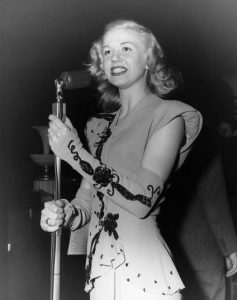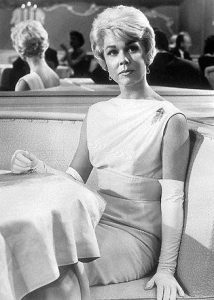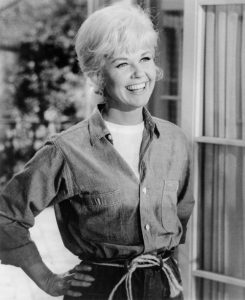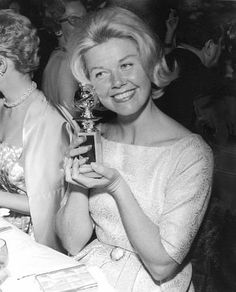
Life and Career
Doris Mary Ann Kappelhoff was born on April 3rd, 1922 (her birth year would later be incorrectly reported as 1924, a date that still appears in some locations) in Cincinnati. Interested in performing from a young age, Doris’ chances of becoming a dancer were ended when a car accident in 1937 injured her legs. She turned instead to singing, and changed her last name to Day in 1939.
Doris worked her way up in the music industry, performing with some of the biggest names of the 40s’, and in 1945 she made it to the top with the hit song Sentimental Journey. By 1946 she was the highest paid female band vocalist in the world – and the big screen was calling. Her love life, however, was not so successful.
Doris married trombonist Al Jorden in 1941, but they divorced two years later among rumours of physical abuse. The marriage did, however, bring Day her one and only child, son Terry. She married again in 1946, this time to saxophonist George Weidler, but the marriage didn’t last through the end of the decade.
Doris signed a contract with Warner Bros., and when Betty Hutton was forced to withdraw from Romance on the High Seas (1948) due to her pregnancy, Doris Day stepped into her first movie role. Her status as a well-known singer led to many roles in musical comedies throughout the early 1950s putting her on the Hollywood map. In 1955 Doris shifted gears with several dramatic roles, including The Man Who Knew Too Much, an Alfred Hitchcock film opposite James Stewart, but it wasn’t long before she found the niche for which is remains best known to this day – the romantic comedy. It was during her rise on the screen that she married for a third time. Martin Melcher was a music producer and again, a musician, but this time the marriage was not so short lived. Melcher started to play a role in Doris’ career, and she would later discover he had squandered millions of dollars of her money.
Doris earned an Academy Award nomination for her role in Pillow Talk (1959), among other successful romantic comedy roles, but as the sexual revolution of the 60s gained momentum, Day’s virginal girl-next-door image didn’t appeal to audiences as it once had. In 1968 she filmed her last movie, With Six You Get Egg Roll.
The year was one of great change for Doris; her husband passed away at the age of 52. Both Doris and Martin were Christian Scientists, and as a result they sought no treatment for the ailments that ended Martin’s life. After a health scare of her own, and the news that her late husband had left her in a financial disaster, Doris Day returned to the screen – this time the small screen. The Doris Day Show ran from 1968-1973.
With her acting career behind her, Doris Day married for a fourth time in 1976, and not to a musician this time. During her marriage to Barry Comden, a maître d’hotel in Beverly Hills, Day channeled her energy into animal activism. She founded The Doris Day Pet Foundation in 1978, a focus that her husband would blame for the dissolution of the marriage – they divorced in 1981. Doris never remarried, but to this day continues to fight for animal rights through various charities.
In 2011, Doris Day became the oldest artist to reach the UK Top 10 with the release of a new album, My Heart. Featuring a variety of previously unreleased tracks, the album was sold in support of the Doris Day Animal League and included a track dedicated to her son, Terry Melcher, who passed away in 2004 from melanoma.
Doris Day remains one of the last living legends of Marilyn’s days and the Golden Age of Hollywood.
Marilyn Connections
Perhaps one of the best-known connections between Marilyn and Doris Day is Marilyn’s last film, Something’s Got to Give. Day was one of those approached to take over Marilyn’s role when she was fired by Fox, but she declined. Doris eventually agreed to make the film in 1963 after Marilyn’s death, and it was renamed Move Over, Darling. The sets built for Something’s Got to Give, as well as some costumes were reused in the film. Frequent Marilyn co-star Thelma Ritter also appeared in the film. Doris was nominated for a Golden Globe for her role.
Another film both considered was The Sleeping Prince. Day had plans in motion to star in a film adaptation to be made in England. Marilyn, however, bought the rights to the play and filmed it as The Prince and The Showgirl.
Like Marilyn, Doris Day named Ella Fitzgerald as her favourite singer, and listened to her albums to improve her own singing skills.
“The one radio voice I listened to above others belonged to Ella Fitzgerald. There was a quality to her voice that fascinated me, and I’d sing along with her, trying to catch the subtle ways she shaded her voice, the casual yet clean way she sang the words.”
In addition to Thelma Ritter, who appeared in several supporting roles in Doris Day films just as she did in some of Marilyn’s films, Day also shared a few other co-stars with Marilyn. She appeared in It Happened To Jane with Marilyn’s Some Like it Hot co-star, Jack Lemmon. The Tunnel of Love placed her opposite Richard Widmark, who worked with Marilyn on Don’t Bother To Knock, and she made Teacher’s Pet with Clark Gable. She also appeared with Lauren Bacall in 1950’s Young Man With a Horn. The year Marilyn died, Doris made That Touch of Mink with Marilyn’s Monkey Business co-star, Cary Grant. Day also worked with Marilyn’s close friend Frank Sinatra, while fellow Rat-Packer Peter Lawford appeared in several episodes of The Doris Day Show.
Doris attended the Seven Year Itch party at Romanoff’s in 1954, so it’s very likely the two met on that occasion.
Marilyn and Doris were both nominated for the Best Actress in a Musical or Comedy award at the 1960 Golden Globes, and both attended the ceremony, where Marilyn won. Doris took home the Henrietta Award for World Film Favourite, a title Marilyn had won before and would win again in 1962. Again, it seems likely they would have run into each other at the ceremony.
Although on the surface Doris Day and Marilyn Monroe – the girl next door and the sex symbol – were polar opposites, they had some things in common. Both loved animals, both counted some of Hollywood’s famously closeted gay men among their close friends (Doris made multiple films with Rock Hudson and was very close friends with him), and both had little interest in wealth. However, Doris’ clean image and conservative beliefs were not just on the surface, and unlike Marilyn she refused to do any nudity. But in the end, both just wanted their work to make people happy.
“I want to smile and I want to make people laugh. And that’s all I want. I like it. I like being happy. I want to make others happy.”
-Leslie Kasperowicz for Immortal Marilyn










